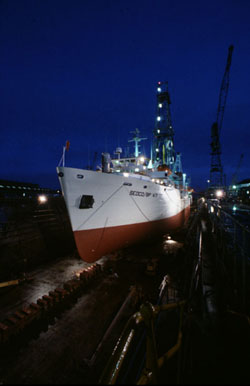Core Image Capture System
 Color is a readily observable physical property, and one which has long been used by
geologists to correlate beds visible in outcrops. Unfortunately, the colors of most fresh
marine sediments are too ephemeral, and color differences between layers typically are too
subtle and too abundant for quantitative work to be accomplished reliably by human
inspection. Overcoming these problems with a digital imaging system would allow scientists
(1) to collect high-resolution images of the cores, while they are fresh, for later scientific
study, and (2) to study color variation with depth as an indicator of geologic processes
(time-series analysis) in a fashion similar to the MST-track measurements.
Color is a readily observable physical property, and one which has long been used by
geologists to correlate beds visible in outcrops. Unfortunately, the colors of most fresh
marine sediments are too ephemeral, and color differences between layers typically are too
subtle and too abundant for quantitative work to be accomplished reliably by human
inspection. Overcoming these problems with a digital imaging system would allow scientists
(1) to collect high-resolution images of the cores, while they are fresh, for later scientific
study, and (2) to study color variation with depth as an indicator of geologic processes
(time-series analysis) in a fashion similar to the MST-track measurements.
During 28-29 March 1996, the JANUS core description workshop met to define its
specification for a core digital-image capture system. In doing so, it considered the
requirements of the ODP core description workshop, IHP, SMP, JANUS, and ODP/TAMU.
Based on presentations from and discussions with these groups, a summary of the minimum
requirements for such a system has been developed:
- A minimum resolution of 3 pixels per mm;
- Image capture at a maximum time of 1 hr per core;
- Color spectral data capture using a standard color system (e.g., CIE); and
- Robustness (i.e., can withstand repeated and continuous use rates typical of those seen
on high-recovery paleoceanographic cruises).
The group agreed that the most likely image-capture configuration is a medium-resolution
camera, capturing images on a split-core track that moves the core past the camera at
user-defined intervals.
Funds budgeted for this project will support hardware and software procurement during
FY97, when the system will be substantially completed.

To Semiannual Report Contents
To New Initiatives Contents